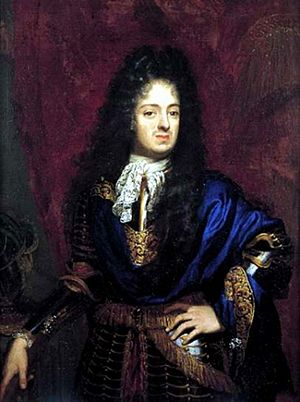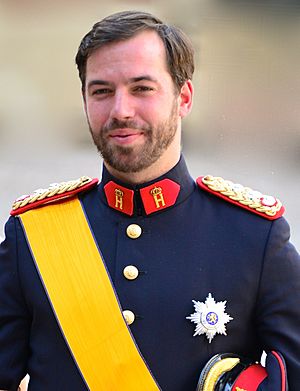Titles of European royal heirs facts for kids


Many countries in Europe, both in the past and today, have special titles for the person who is next in line to become the monarch (king or queen). This person is called the heir apparent. A famous example is Charles III, who was known as the Prince of Wales for many years as the heir to the British throne. Often, the heir is called a "Crown Prince" or "Crown Princess."
Contents
Titles for Heirs to Thrones
Heirs to thrones in different kingdoms have used many unique titles. These titles often show the history and traditions of their country.
Titles in Kingdoms Today
- Prince of Wales: This is the main title for the heir to the British throne. The heir also holds many other titles like Duke of Cornwall and Duke of Rothesay.
- Crown Prince of Sweden: Used in Sweden. The current heir is Victoria, Crown Princess of Sweden.
- Crown Prince of Norway: Used in Norway.
- Prince of Orange: Used by the heir to the throne of the Kingdom of the Netherlands.
- Crown Prince of Denmark: Used by the heir to the Danish throne.
- Prince of Asturias: Used by the heir to the Spanish throne.
- Duke of Brabant: Used by the heir to the Belgian throne.
Titles in Former Kingdoms
- Dauphin of France: This title was used by the heir to the French throne when France was a monarchy.
- Crown Prince of Prussia & German Crown Prince: Used by the heir to the German Empire.
- Tsarevich of Russia: Used by the heir to the Russian Imperial throne.
- Crown Prince of Greece: Sometimes also called Duke of Sparta. Used by the heir to the Greek throne.
- King of the Romans: This was a very important title for the heir to the Holy Roman Emperor. This person was expected to rule the Holy Roman Empire next.
- Prince of Brazil: When Portugal was a monarchy, this title was used by the heir. It replaced an older title, Prince of Beira. The heir also held the title Duke of Braganza.
- Crown Prince of Hanover: Used by the heir to the Kingdom of Hanover.
Titles in Other States
Besides kingdoms, some smaller states also had special titles for their heirs.
General Titles for Heirs
- Hereditary Prince of Monaco: Used by the heir to the Principality of Monaco.
- Hereditary Prince of Liechtenstein: Used by the heir to the Principality of Liechtenstein.
- Hereditary Grand Duke of Luxembourg: Used by the heir to the Grand Duchy of Luxembourg.
Titles in German States
Before Germany became one country, it was made up of many smaller states. These included principalities, duchies, and grand duchies. Most of them used titles like "Hereditary Prince" or "Hereditary Grand Duke" followed by the name of their state.
- Hereditary Prince of Baden: The heir to the Grand Duchy of Baden.
- Hereditary Grand Duke of Hesse: The heir to the Grand Duchy of Hesse.
- Hereditary Grand Duke of Oldenburg: The heir to the Grand Duchy of Oldenburg.
- Hereditary Prince of the Palatinate: The heir to the Electorate of the Palatinate.
- Hereditary Prince of Saxe-Coburg and Gotha: The heir to the Duchy of Saxe-Coburg and Gotha.
- Hereditary Grand Duke of Mecklenburg-Schwerin: The heir to the Grand Duchy of Mecklenburg-Schwerin.
- Hereditary Prince of Waldeck and Pyrmont: The heir to the Principality of Waldeck and Pyrmont.
Titles in Italian States
Italy was also made up of many smaller states before it became one country. Heirs in these states had their own special titles.
- Hereditary Prince of Naples: Used by the heir to the Kingdom of Naples. After Naples joined with Sicily in 1825 to form the Kingdom of the Two Sicilies, the title Duke of Calabria was used instead.
- Grand Prince of Tuscany: Used by the heir to the Grand Duchy of Tuscany.
- Prince of Piedmont: Used by the heir to the Duchy of Savoy. When Savoy became the Kingdom of Sardinia, the title Duke of Savoy was also used by the heir.
- Hereditary Prince of Modena: The heir to the Duchy of Modena.
- Hereditary Prince of Parma: The heir to the Duchy of Parma.
Famous Heirs and Their Titles
Here are some examples of people who held these special titles:
- Ferdinando de' Medici, Grand Prince of Tuscany was known as the Grand Prince his whole life. He sadly died before his father, so he never became the ruler.
- Philippe of Belgium is the current King of the Belgians. Before he became king in 2013, he was known as the Duke of Brabant starting in 1993.
- King Victor Amadeus III of Sardinia was known as the Duke of Savoy from 1726 to 1773, before he became king.
- Emperor Wilhelm II was known as the Crown Prince of Prussia and German Crown Prince for six months in 1888, just before he became emperor.
- Queen Charlotte of Württemberg was known as The Hereditary Princess of Württemberg for five months in 1797.


